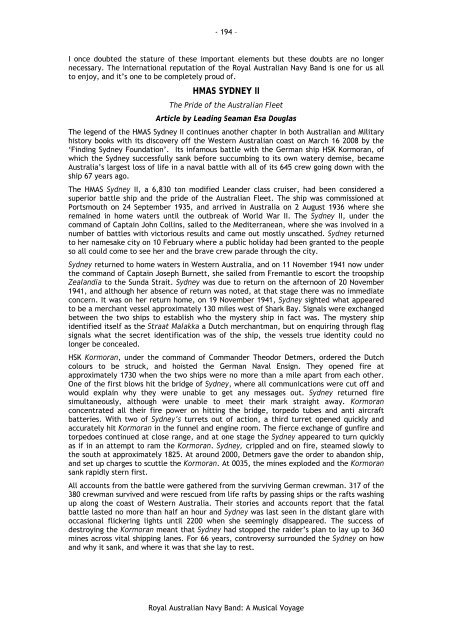A MUSICAL VOYAGE - Royal Australian Navy
A MUSICAL VOYAGE - Royal Australian Navy
A MUSICAL VOYAGE - Royal Australian Navy
You also want an ePaper? Increase the reach of your titles
YUMPU automatically turns print PDFs into web optimized ePapers that Google loves.
- 194 –<br />
I once doubted the stature of these important elements but these doubts are no longer<br />
necessary. The international reputation of the <strong>Royal</strong> <strong>Australian</strong> <strong>Navy</strong> Band is one for us all<br />
to enjoy, and it’s one to be completely proud of.<br />
HMAS SYDNEY II<br />
The Pride of the <strong>Australian</strong> Fleet<br />
Article by Leading Seaman Esa Douglas<br />
The legend of the HMAS Sydney II continues another chapter in both <strong>Australian</strong> and Military<br />
history books with its discovery off the Western <strong>Australian</strong> coast on March 16 2008 by the<br />
‘Finding Sydney Foundation’. Its infamous battle with the German ship HSK Kormoran, of<br />
which the Sydney successfully sank before succumbing to its own watery demise, became<br />
Australia’s largest loss of life in a naval battle with all of its 645 crew going down with the<br />
ship 67 years ago.<br />
The HMAS Sydney II, a 6,830 ton modified Leander class cruiser, had been considered a<br />
superior battle ship and the pride of the <strong>Australian</strong> Fleet. The ship was commissioned at<br />
Portsmouth on 24 September 1935, and arrived in Australia on 2 August 1936 where she<br />
remained in home waters until the outbreak of World War II. The Sydney II, under the<br />
command of Captain John Collins, sailed to the Mediterranean, where she was involved in a<br />
number of battles with victorious results and came out mostly unscathed. Sydney returned<br />
to her namesake city on 10 February where a public holiday had been granted to the people<br />
so all could come to see her and the brave crew parade through the city.<br />
Sydney returned to home waters in Western Australia, and on 11 November 1941 now under<br />
the command of Captain Joseph Burnett, she sailed from Fremantle to escort the troopship<br />
Zealandia to the Sunda Strait. Sydney was due to return on the afternoon of 20 November<br />
1941, and although her absence of return was noted, at that stage there was no immediate<br />
concern. It was on her return home, on 19 November 1941, Sydney sighted what appeared<br />
to be a merchant vessel approximately 130 miles west of Shark Bay. Signals were exchanged<br />
between the two ships to establish who the mystery ship in fact was. The mystery ship<br />
identified itself as the Straat Malakka a Dutch merchantman, but on enquiring through flag<br />
signals what the secret identification was of the ship, the vessels true identity could no<br />
longer be concealed.<br />
HSK Kormoran, under the command of Commander Theodor Detmers, ordered the Dutch<br />
colours to be struck, and hoisted the German Naval Ensign. They opened fire at<br />
approximately 1730 when the two ships were no more than a mile apart from each other.<br />
One of the first blows hit the bridge of Sydney, where all communications were cut off and<br />
would explain why they were unable to get any messages out. Sydney returned fire<br />
simultaneously, although were unable to meet their mark straight away. Kormoran<br />
concentrated all their fire power on hitting the bridge, torpedo tubes and anti aircraft<br />
batteries. With two of Sydney’s turrets out of action, a third turret opened quickly and<br />
accurately hit Kormoran in the funnel and engine room. The fierce exchange of gunfire and<br />
torpedoes continued at close range, and at one stage the Sydney appeared to turn quickly<br />
as if in an attempt to ram the Kormoran. Sydney, crippled and on fire, steamed slowly to<br />
the south at approximately 1825. At around 2000, Detmers gave the order to abandon ship,<br />
and set up charges to scuttle the Kormoran. At 0035, the mines exploded and the Kormoran<br />
sank rapidly stern first.<br />
All accounts from the battle were gathered from the surviving German crewman. 317 of the<br />
380 crewman survived and were rescued from life rafts by passing ships or the rafts washing<br />
up along the coast of Western Australia. Their stories and accounts report that the fatal<br />
battle lasted no more than half an hour and Sydney was last seen in the distant glare with<br />
occasional flickering lights until 2200 when she seemingly disappeared. The success of<br />
destroying the Kormoran meant that Sydney had stopped the raider’s plan to lay up to 360<br />
mines across vital shipping lanes. For 66 years, controversy surrounded the Sydney on how<br />
and why it sank, and where it was that she lay to rest.<br />
<strong>Royal</strong> <strong>Australian</strong> <strong>Navy</strong> Band: A Musical Voyage

















